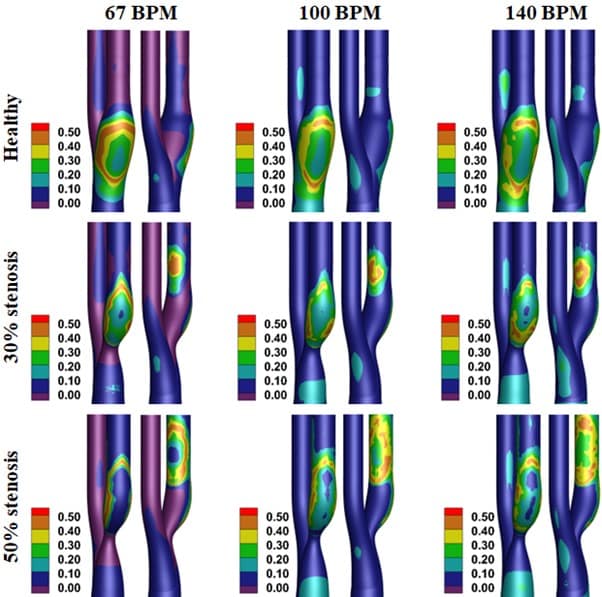Atherosclerosis is a type of cardiovascular disease caused by the buildup of cholesterol, lipids, and other particles in the arteries. It does not exhibit symptoms at first. As plaque accumulates, lumen size decreases, resulting in stenosis, which restricts blood flow to vital organs such as the brain.
Local hemodynamics have an important impact on artery wall shear stress (WSS), which is directly related to the development of atherosclerosis.
Many people ignore the warnings posted before gym sessions that advise them to consult a doctor before engaging in strenuous exercise. Isn’t it true that exercise is healthy for people? Certain diseases, however, may make the higher heart rate associated with exercise harmful.
The Indian Institute of Technology Kharagpur researchers discovered that a higher heart rate associated with exercise could cause a stroke in patients with severely clogged carotid arteries. Conversely, exercise is useful for maintaining healthy blood flow in healthy patients and those with only mildly obstructed arteries.
Carotid arteries are positioned on both sides of the neck, giving blood flow to facial tissues and the brain. When fat, cholesterol and other particles accumulate on the inner carotid walls, they combine to create a plaque, which narrows the artery.
This constriction, known as stenosis, aestricts blood flow to the brain, resulting in a stroke. An increased heart rate in healthy people raises and stabilizes the drag force blood exerts on the artery wall, lowering the likelihood of stenosis. However, it may be less helpful for people with stenosis.
The researchers utilized a specialized computational model to simulate blood flow in the carotid arteries at three degrees of stenosis: none, mild 30% obstruction, and significant 50% occlusion. They evaluated the effects of a 140-bpm exercise-induced heart rate with resting heart rates of 67 and 100 bpm.

The workout condition, as expected, increased the health of the simulated carotid in healthy and mild cases. The outcomes with substantial obstruction, on the other hand, were alarming.
Somnath Roy said, “Intense exercise shows adverse effects on patients with moderate or higher stenosis levels. It substantially increases the shear stress at the stenosis zone, which may cause the stenosis to rupture. This ruptured plaque may flow to the brain and its blood supply, causing ischemic stroke.”
Many factors, including age, lifestyle, and genetics, contribute to the risk of stenosis and stroke. The authors propose that people who engage in strenuous exercise have their artery health checked regularly and that people with moderate to severe stenosis or a history of strokes follow a carefully recommended exercise routine.
The result of the study shows that the researcher investigated the influence of increased heart rate on hemodynamics in healthy and stenosed carotid arteries by modeling blood as Carreau fluid and running computer simulations based on physiologically relevant data with a GPU-accelerated sharp interface IB solver. They examined two stenotic carotid arteries with 30% and 50% stenosis.
Journal Reference:
- Piru Mohan Khan, Siddharth D. Sharma, et al.Effect of heart rate on the hemodynamics in healthy and stenosed carotid arteries. Physics of Fluids. DOI: 10.1063/5.0153323
